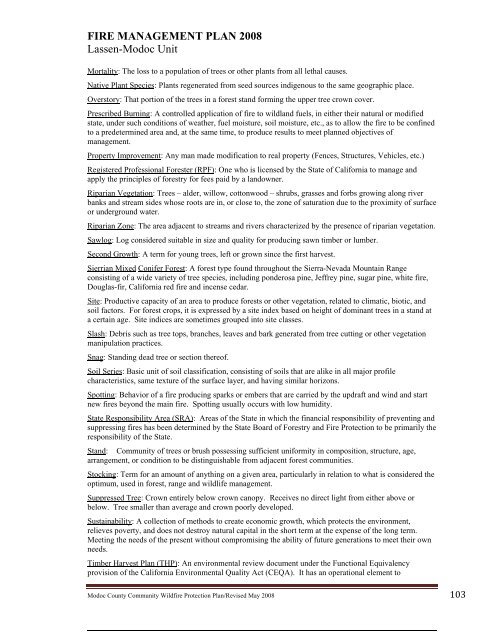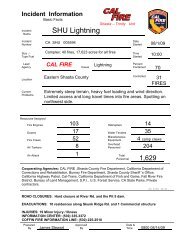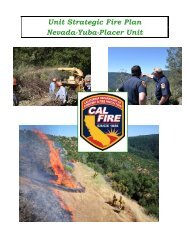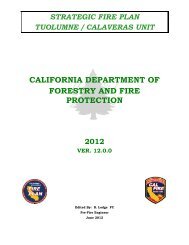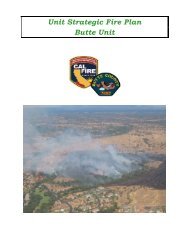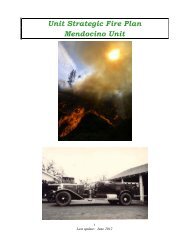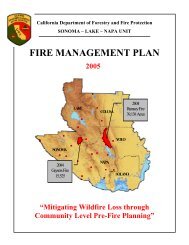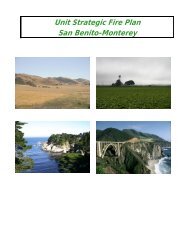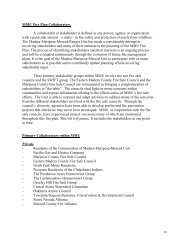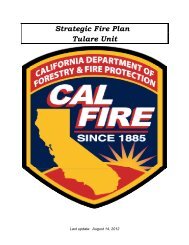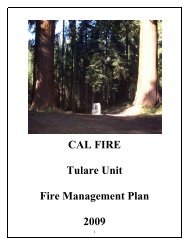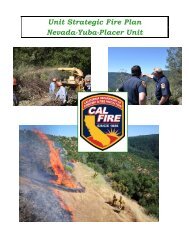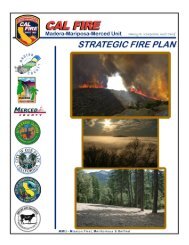Lassen – Modoc Unit - Board of Forestry and Fire Protection - State ...
Lassen – Modoc Unit - Board of Forestry and Fire Protection - State ...
Lassen – Modoc Unit - Board of Forestry and Fire Protection - State ...
You also want an ePaper? Increase the reach of your titles
YUMPU automatically turns print PDFs into web optimized ePapers that Google loves.
FIRE MANAGEMENT PLAN 2008<br />
<strong>Lassen</strong>-<strong>Modoc</strong> <strong>Unit</strong><br />
Mortality: The loss to a population <strong>of</strong> trees or other plants from all lethal causes.<br />
Native Plant Species: Plants regenerated from seed sources indigenous to the same geographic place.<br />
Overstory: That portion <strong>of</strong> the trees in a forest st<strong>and</strong> forming the upper tree crown cover.<br />
Prescribed Burning: A controlled application <strong>of</strong> fire to wildl<strong>and</strong> fuels, in either their natural or modified<br />
state, under such conditions <strong>of</strong> weather, fuel moisture, soil moisture, etc., as to allow the fire to be confined<br />
to a predetermined area <strong>and</strong>, at the same time, to produce results to meet planned objectives <strong>of</strong><br />
management.<br />
Property Improvement: Any man made modification to real property (Fences, Structures, Vehicles, etc.)<br />
Registered Pr<strong>of</strong>essional Forester (RPF): One who is licensed by the <strong>State</strong> <strong>of</strong> California to manage <strong>and</strong><br />
apply the principles <strong>of</strong> forestry for fees paid by a l<strong>and</strong>owner.<br />
Riparian Vegetation: Trees <strong>–</strong> alder, willow, cottonwood <strong>–</strong> shrubs, grasses <strong>and</strong> forbs growing along river<br />
banks <strong>and</strong> stream sides whose roots are in, or close to, the zone <strong>of</strong> saturation due to the proximity <strong>of</strong> surface<br />
or underground water.<br />
Riparian Zone: The area adjacent to streams <strong>and</strong> rivers characterized by the presence <strong>of</strong> riparian vegetation.<br />
Sawlog: Log considered suitable in size <strong>and</strong> quality for producing sawn timber or lumber.<br />
Second Growth: A term for young trees, left or grown since the first harvest.<br />
Sierrian Mixed Conifer Forest: A forest type found throughout the Sierra-Nevada Mountain Range<br />
consisting <strong>of</strong> a wide variety <strong>of</strong> tree species, including ponderosa pine, Jeffrey pine, sugar pine, white fire,<br />
Douglas-fir, California red fire <strong>and</strong> incense cedar.<br />
Site: Productive capacity <strong>of</strong> an area to produce forests or other vegetation, related to climatic, biotic, <strong>and</strong><br />
soil factors. For forest crops, it is expressed by a site index based on height <strong>of</strong> dominant trees in a st<strong>and</strong> at<br />
a certain age. Site indices are sometimes grouped into site classes.<br />
Slash: Debris such as tree tops, branches, leaves <strong>and</strong> bark generated from tree cutting or other vegetation<br />
manipulation practices.<br />
Snag: St<strong>and</strong>ing dead tree or section there<strong>of</strong>.<br />
Soil Series: Basic unit <strong>of</strong> soil classification, consisting <strong>of</strong> soils that are alike in all major pr<strong>of</strong>ile<br />
characteristics, same texture <strong>of</strong> the surface layer, <strong>and</strong> having similar horizons.<br />
Spotting: Behavior <strong>of</strong> a fire producing sparks or embers that are carried by the updraft <strong>and</strong> wind <strong>and</strong> start<br />
new fires beyond the main fire. Spotting usually occurs with low humidity.<br />
<strong>State</strong> Responsibility Area (SRA): Areas <strong>of</strong> the <strong>State</strong> in which the financial responsibility <strong>of</strong> preventing <strong>and</strong><br />
suppressing fires has been determined by the <strong>State</strong> <strong>Board</strong> <strong>of</strong> <strong>Forestry</strong> <strong>and</strong> <strong>Fire</strong> <strong>Protection</strong> to be primarily the<br />
responsibility <strong>of</strong> the <strong>State</strong>.<br />
St<strong>and</strong>: Community <strong>of</strong> trees or brush possessing sufficient uniformity in composition, structure, age,<br />
arrangement, or condition to be distinguishable from adjacent forest communities.<br />
Stocking: Term for an amount <strong>of</strong> anything on a given area, particularly in relation to what is considered the<br />
optimum, used in forest, range <strong>and</strong> wildlife management.<br />
Suppressed Tree: Crown entirely below crown canopy. Receives no direct light from either above or<br />
below. Tree smaller than average <strong>and</strong> crown poorly developed.<br />
Sustainability: A collection <strong>of</strong> methods to create economic growth, which protects the environment,<br />
relieves poverty, <strong>and</strong> does not destroy natural capital in the short term at the expense <strong>of</strong> the long term.<br />
Meeting the needs <strong>of</strong> the present without compromising the ability <strong>of</strong> future generations to meet their own<br />
needs.<br />
Timber Harvest Plan (THP): An environmental review document under the Functional Equivalency<br />
provision <strong>of</strong> the California Environmental Quality Act (CEQA). It has an operational element to<br />
<strong>Modoc</strong> County Community Wildfire <strong>Protection</strong> Plan/Revised May 2008 103


